A Good Friday day tour today in North Norfolk. The weather forecast was for blue skies and sunshine, and so it turned out, even if there was still a lingering chill in the wind at times. It really felt like spring – at last!
We started the day at Blakeney. On the walk out along the seawall, a very smart male Marsh Harrier drifted across the freshmarsh towards us and across the path just ahead of us, flashing its silvery grey wings with black wingtips. The tide was in and it was quite a big tide today. A flock of Oysterctachers was roosting up on one of the dry saltmarsh islands and several small groups of Brent Geese were flying round the harbour.
We could see a small crowd gathered down by the gate as we approached – a phalanx of photographers waiting for the Lapland Buntings. We joined the line and it wasn’t long before we spotted one creeping around in the grass in front of us. Helpfully then it stopped and perched up on a small ridge of bare earth. It preened itself briefly and then started singing. This is a rare treat, to hear Lapland Buntings singing in the UK. The song itself is not really anything to write home about though!
It was not a great view of the Lapland Bunting in the grass, but thankfully one then flew out and landed on the path right in front of us, giving us amazing views. The local photographers have been liberally sprinkling seed around the area and the Lapland Buntings have been happily taking advantage. Even though they are normally rather skulking birds, they can be very tame and certainly these do not seem concerned unless people get too close.
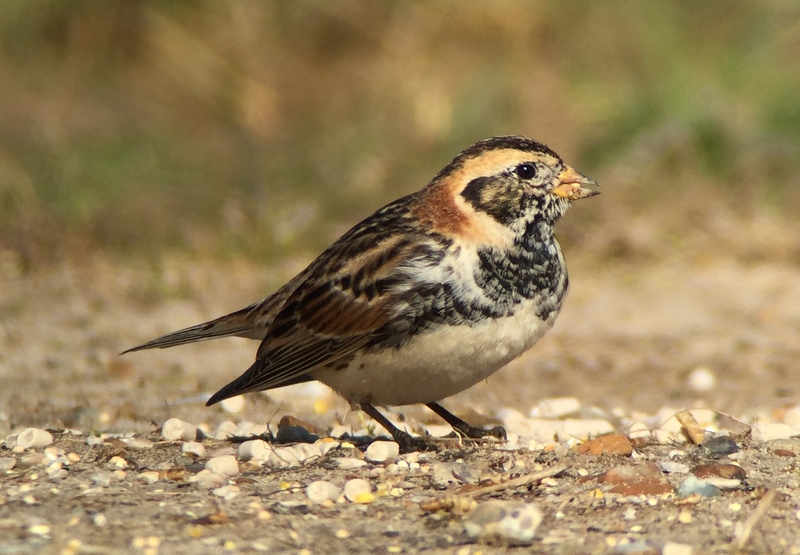 Lapland Bunting – we had some great views of them today
Lapland Bunting – we had some great views of them today
We stayed a while and watched the comings and goings of the Lapland Buntings. There were at least 8 here today. Some of the males are rapidly developing their summer plumage now – their faces are going increasingly black. One male in particular was singing continually from behind us, out on the edge of a large puddle.
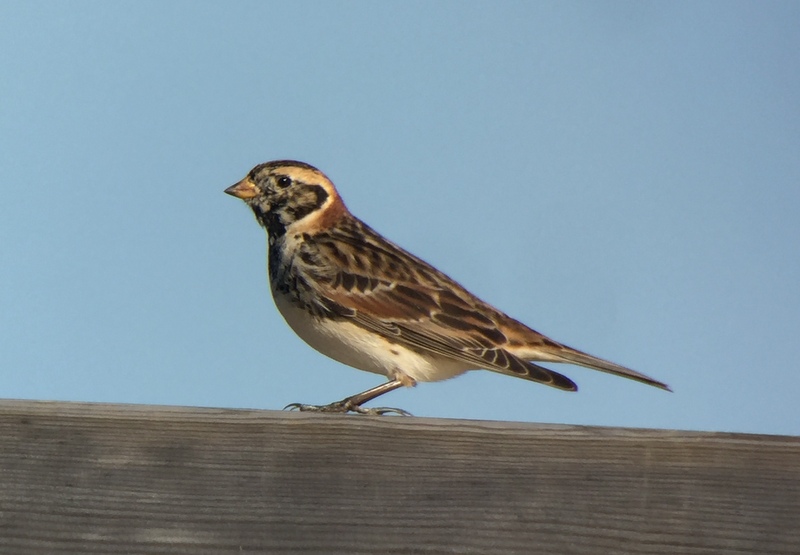 Lapland Bunting – a couple of the males were singing
Lapland Bunting – a couple of the males were singing
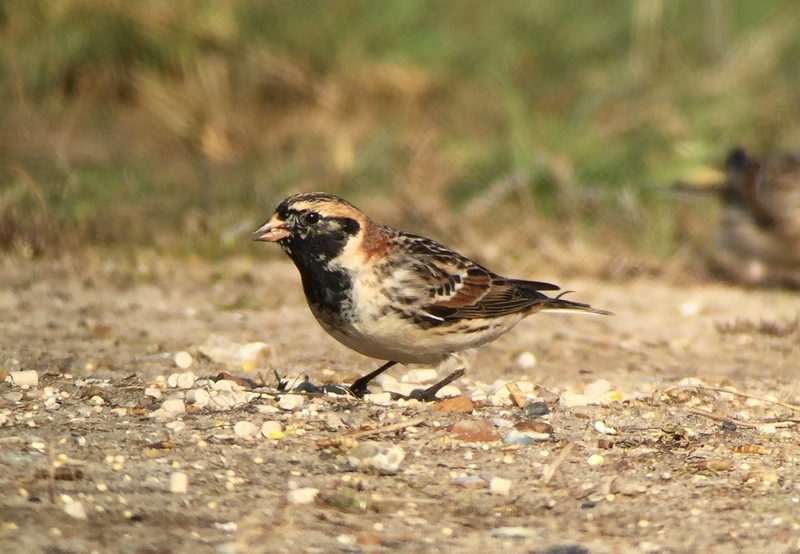 Lapland Bunting – some of the males are now getting very black faces
Lapland Bunting – some of the males are now getting very black faces
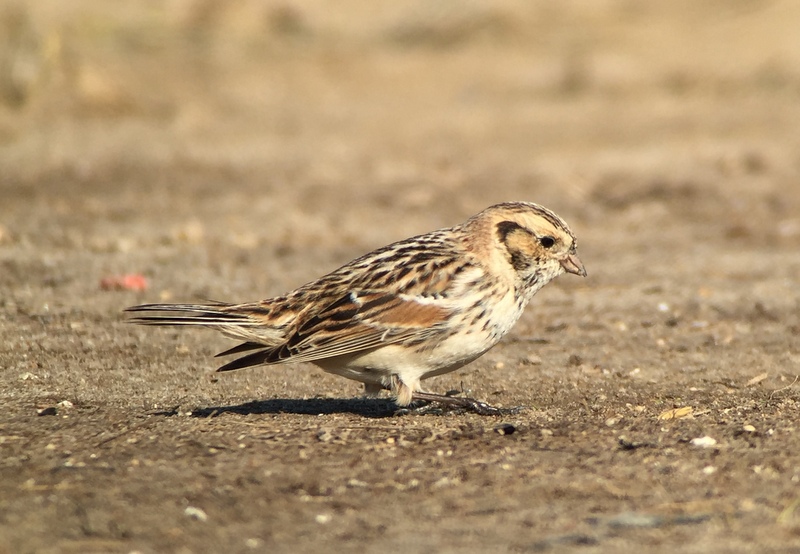 Lapland Bunting – the females are more subtly coloured
Lapland Bunting – the females are more subtly coloured
There were other birds taking advantage of the seed and we had great views of Skylarks and Reed Buntings coming down in front of us too. Unfortunately, a Jack Snipe was less accommodating. It flew up from the long grass and disappeared over the seawall and down the other side, before anyone could really get onto it. A Stonechat perched up more distantly on a post and a male Marsh Harrier started displaying high in the sky above the reedbed.
 Skylark – also coming down to the seed
Skylark – also coming down to the seed
With such a clear day, we had hoped there might be some more obvious signs of visible migration, early birds on the move along the coast. But the only two birds we saw which appeared to be migrants were two Pied Wagtails which flew in along the line of the seawall and continued on west without stopping. Perhaps the lingering chill in the air was just enough to keep a lid on things.
Eventually we decided to tear ourselves from the Lapland Buntings and move on. Out in the harbour, the tide had started to go out. There were more waders now out on the mud, a scattering of Knot and Dunlin, a few Grey Plover and some distant Bar-tailed Godwits. Some of the Brent Geese were now out on the mud too and scanning through them we found a single Pale-bellied Brent with all the regular Russian Dark-bellied Brents. A smart Lesser Black-backed Gull was standing on the muddy edge of the harbour when we got back to the car, its yellow legs glowing in the sun.
 Lesser Black-backed Gull – showing off its yellow legs
Lesser Black-backed Gull – showing off its yellow legs
It seemed like a good day to look for some early migrants. We drove round to Cley and walked along the north side of the Eye Field, but there was no sign of the hoped for early Wheatear, just Skylarks, Meadow Pipits and a flock of Starlings feeding out on the grass. A quick look at the sea as we walked back produced a handful of birds moving – a Knot, 2 Dunlin, 3 Brent Geese and a distant Red-throated Diver, all flying W. A quick look at Salthouse failed to locate any obvious migrants either.
A tip-off about a Little Ringed Plover saw us walking out along the East Bank next. There were lots of Lapwings and Redshanks out on the wet grazing marshes below. Both breed here and the Lapwings are displaying now. Further along, on the Serpentine, we found several Ruff – a group of three included one white-headed male, another male with a regular dappled grey-brown head, and a smaller female (a Reeve).
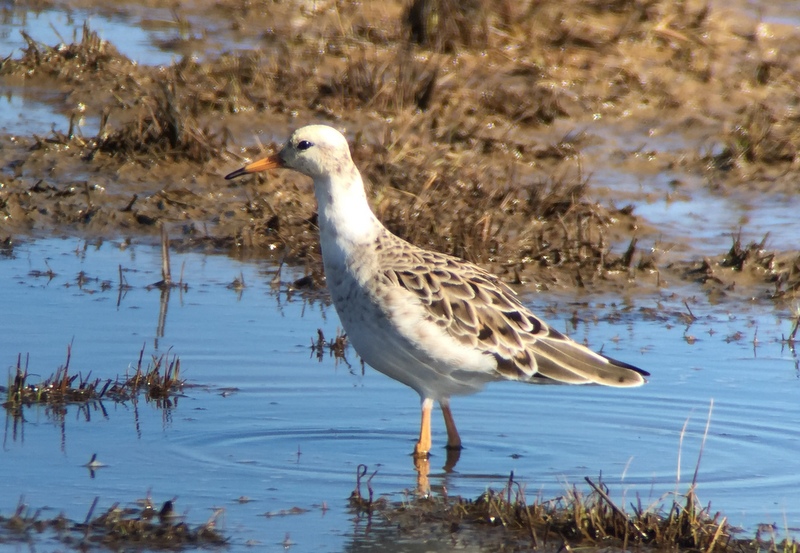 Ruff – a white-headed male on the Serpentine
Ruff – a white-headed male on the Serpentine
It took a careful scan to find a Little Ringed Plover – it was further over, well camouflaged with its back to us on the mud at the back. While we were watching it, a second Little Ringed Plover appeared with it. It was hard to see their yellow eye-rings from this distance, but they are smaller and more elongated in the rear than Ringed Plovers, with a longer, dark bill. At the other end of the same pool, we then found a third Little Ringed Plover – there has obviously been a big arrival of them in recent days, as they are only summer visitors here. A pair of Pintail upending on the Serpentine were a nice addition to the day’s list.
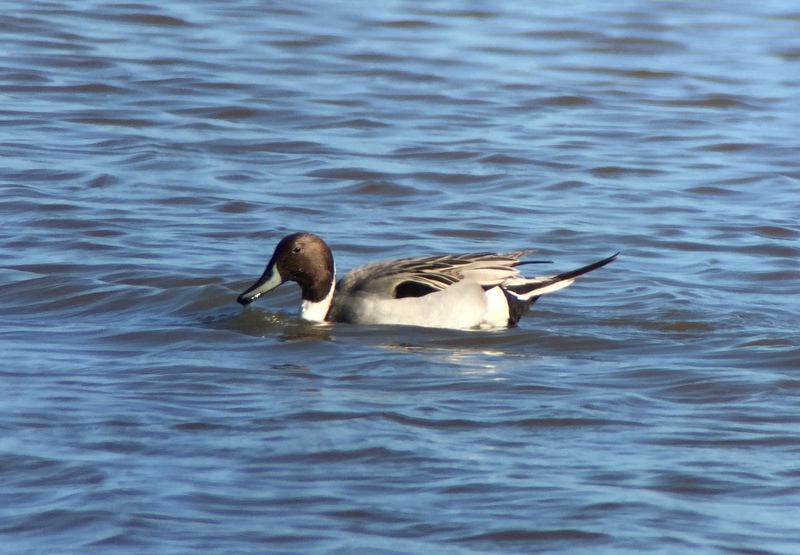 Pintail – a pair were still on the Serpentine
Pintail – a pair were still on the Serpentine
Further along, at Arnold’s Marsh, there were lots more waders. A good number of Avocets are feeding out here at the moment, along with plenty of Dunlin and the usual selection of Oystercatchers, Redshank and Curlew. On one of the stony spits we found a couple of Ringed Plovers – despite the heat haze, we could see their shorter black-tipped orange bills. A flock of Linnets was down at the front on the saltmarsh.
There were several Marsh Harriers over the reeds on Pope’s Marsh and one perched in the top of a bush out in the main Cley reedbed. Scanning the ridge inland, we could see lots of Common Buzzards circling up. One which drifted towards us over the grazing marshes looked like a candidate for a possible migrants, until it folded its wings back and dropped sharply into North Foreland wood. Then it was time to head back for lunch.
In the afternoon we drove over to Holkham. This was not without an amount of trepidation, as the car park can get extremely busy on a sunny bank holiday, and so it proved as Lady Anne’s Drive was packed. Thankfully our gamble that some people would be leaving now was also correct and we managed to find a space not too far from the trees. A quick scan of the grazing marshes either side produced a small group of Pink-footed Geese. The vast majority of the birds which spent the winter here left in February, but small numbers linger in the area for a while longer, so we took advantage to get a good look at them in the scope. A Red Kite circled over the grass just in front of us.
The vast majority of people were just walking straight out to the beach and back, but we turned west along the path on the inland side of the pines, which was much quieter. We hadn’t gone too far before we heard a Chiffchaff singing from the trees. Some overwinter here, but this was most likely a returning summer migrant. Chiffchaff is generally the first migrant warbler to hear singing, a real sign that spring is just around the corner. A Jay perched in a tree nearby seemed to be enjoying the afternoon sunshine.
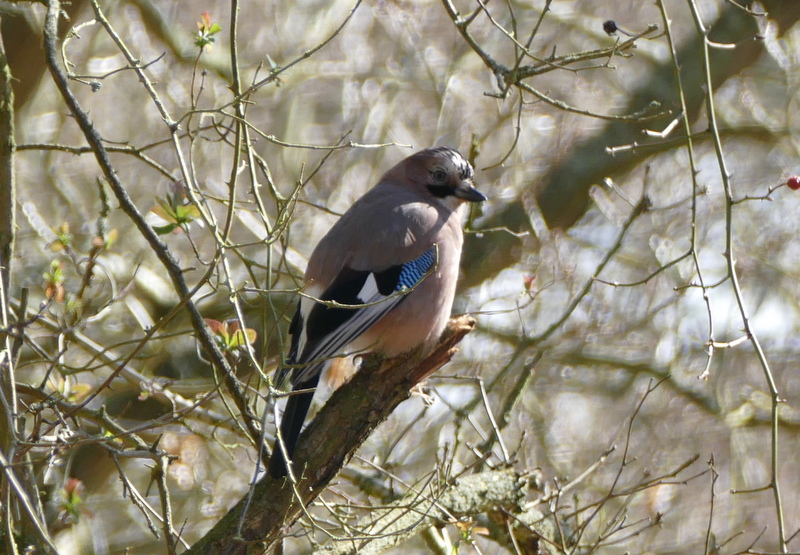 Jay – enjoying the afternoon sunshine
Jay – enjoying the afternoon sunshine
We stopped to have a look at Salts Hole. A raft of ducks out on the water consisted of no less than 17 Tufted Duck, plus a couple of Wigeon. Nearby, a couple of Little Grebes were diving continually. Six Common Buzzards circled high over the trees, calling, but were most likely just the local birds enjoying the warmth in the air.
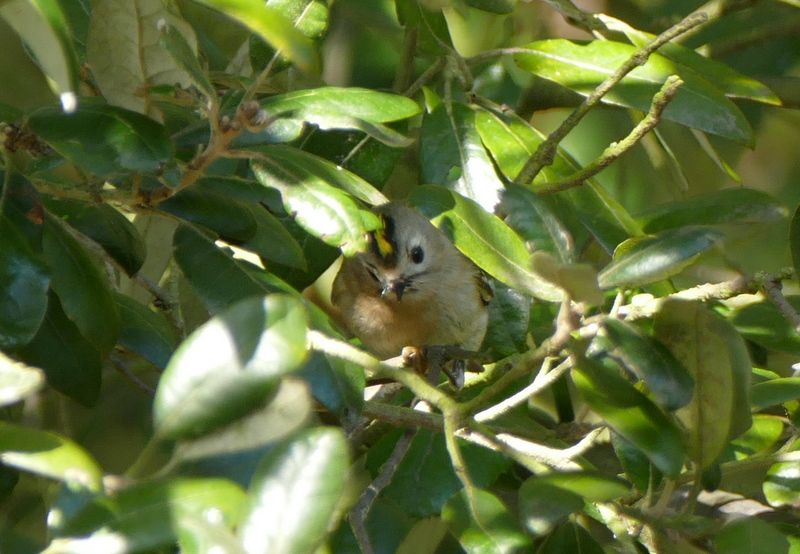 Goldcrest – lots were feeding in the Holm Oaks along the path
Goldcrest – lots were feeding in the Holm Oaks along the path
Just past Salts Hole, the Holm Oaks alive were alive with Goldcrests. The trees here were in full sun, out of the wind, and we could see lots of small insects around the leaves. The Goldcrests were having a field day, picking at the leaves or making little flycatching sorties out from the branches. We stopped to watch them and checking through them carefully we found a Firecrest which appeared briefly in the top of a pine tree. Unfortunately, it promptly disappeared out over the tops of the Holm Oaks.
We walked back a short distance to see if the Firecrest might appear the other side of the trees, and when we turned round and carried on our way, it had reappeared again where it had first been. This time, it dropped down out of the pine into the front of the Holm Oaks just in front of us, at eye level. We got fantastic views of it now, picking at the underside of the leaves and flycatching between the branches. Firecrests really are one of the most stunning little birds.
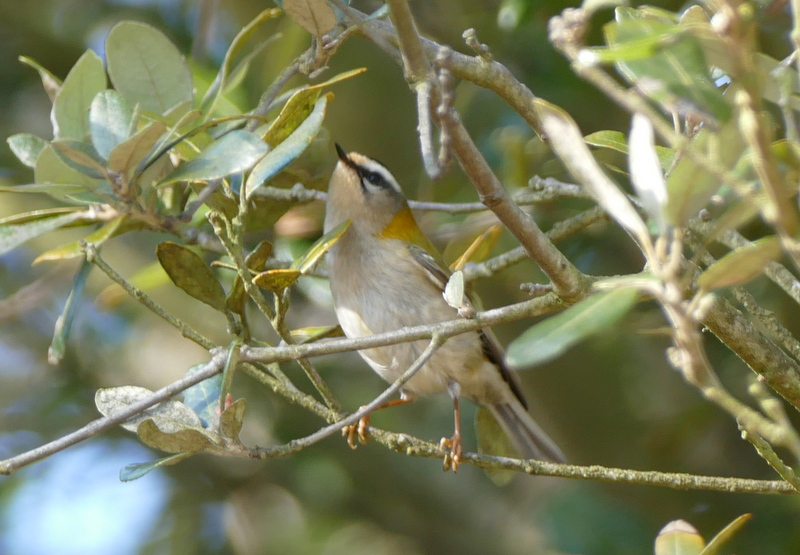 Firecrest – came out to feed in the Holm Oaks just in front of us
Firecrest – came out to feed in the Holm Oaks just in front of us
There were several butterflies out in the sunshine along the path too. A bright orange Comma was basking in the sunshine on the grassy bank in front of the trees and a Small Tortoiseshell was doing the same on the mud from the gate a little further along. We continued on along the path to Joe Jordan Hide.
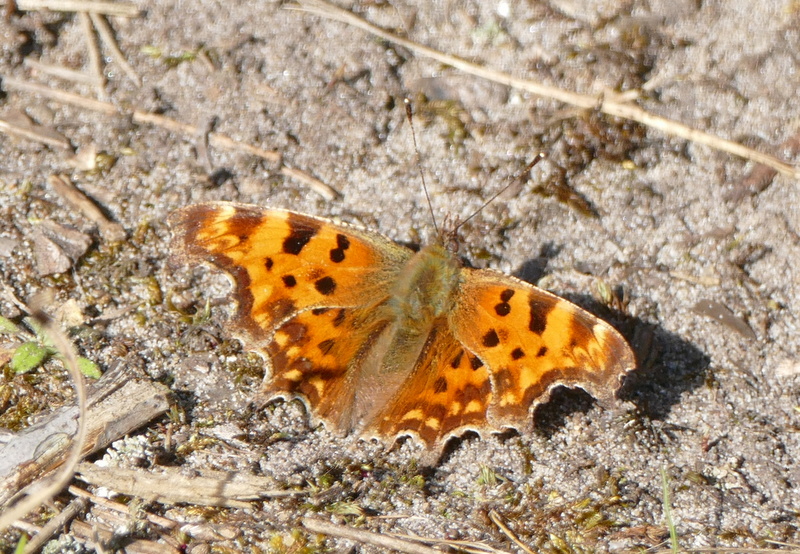 Comma – out in the spring sunshine
Comma – out in the spring sunshine
There were lots of Greylag Geese loafing around on the grass from the hide. Scanning through them, we found a group of six smaller geese in amongst them. These were White-fronted Geese. There is a flock of them here all winter and although many seem to have departed, a small number seem to be lingering still. A more careful scan through the Greylags with the scope revealed there were 12 in total at first, but a few more flew in to join them later, so there were at least 20 when we left.Through the scope, we could see the white blaze around the base of their bills and their distinctive black belly bars.
Several Marsh Harriers were flying in and out of the trees or landing down in the tall grass between the hide and the pool. A Kestrel appeared and started hovering over the bank in front of us, but it seemed to lose interest quickly and flew back into the trees. It then kept dropping down onto the grass in front of the pines, picking up and eating earthworms – obviously much less effort than hovering! A Barn Owl flew out of the trees as well and started quartering the rough grass down below us. It seemed to have more luck than the Kestrel, because it dropped down to the grass and the next thing we knew it had a vole in its bill which it promptly swallowed whole.
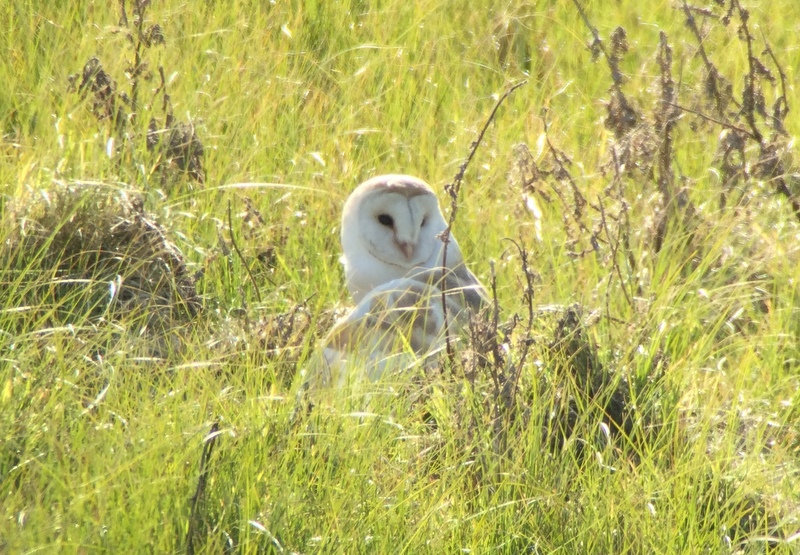 Barn Owl – caught a vole down in the grass
Barn Owl – caught a vole down in the grass
We had heard a Mediterranean Gull calling as we walked out and from the hide we heard the same call again. Looking over to the water to the left of the hide, where there were lots of Black-headed Gulls, we could see a pair of Mediterranean Gulls flying back and forth, flashing their pure white wing tips. They landed on the water and through the scope we could see that they were two smart adults in summer plumage, sporting extensive jet black hoods.
A good number of Pheasants appear to have survived the shooting season and were feeding out on the grass. A pair of Red-legged Partridges appeared too, and started calling. They were obviously having a shout-off against their neighbours, because we could hear another Red-legged Partridge calling back from further over. By comparison, the Grey Partridges were much quieter. They could easily have been overlooked, creeping around in the grass below us, looking rather like the molehills they were in amongst, but the male stood up at one point so we could see his orange face and kidney-shaped blackish-brown belly patch. The drabber female continued to feed quietly nearby.
 Grey Partridge – a pair were creeping around quietly on the grass
Grey Partridge – a pair were creeping around quietly on the grass
We had hoped we might see a Spoonbill here, as they have started to return after the winter (talking to one of the wardens later, up to 8 are now back). At first, all we could see in the trees were Cormorants, loafing around on their guano-stained nests. Then a Spoonbill flew up, but all too briefly as it disappeared again before anyone could get onto it. We waited patiently and even when a Marsh Harrier flew low into the trees, it just managed to flush eight Little Egrets out from exactly where the Spoonbill had landed. Finally a Spoonbill gave itself up properly, flying up out of the trees and circling round in full view of everyone before it dropped back in. That was a nice note to end on, so we walked back slowly in the sunshine to the car.
















